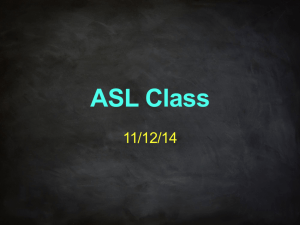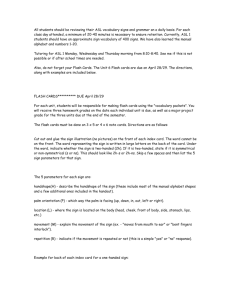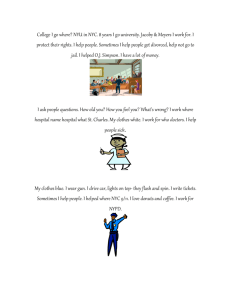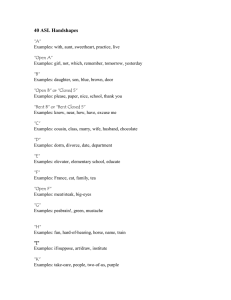Learner Errors and ASL Parameters to be presented in ASL
advertisement
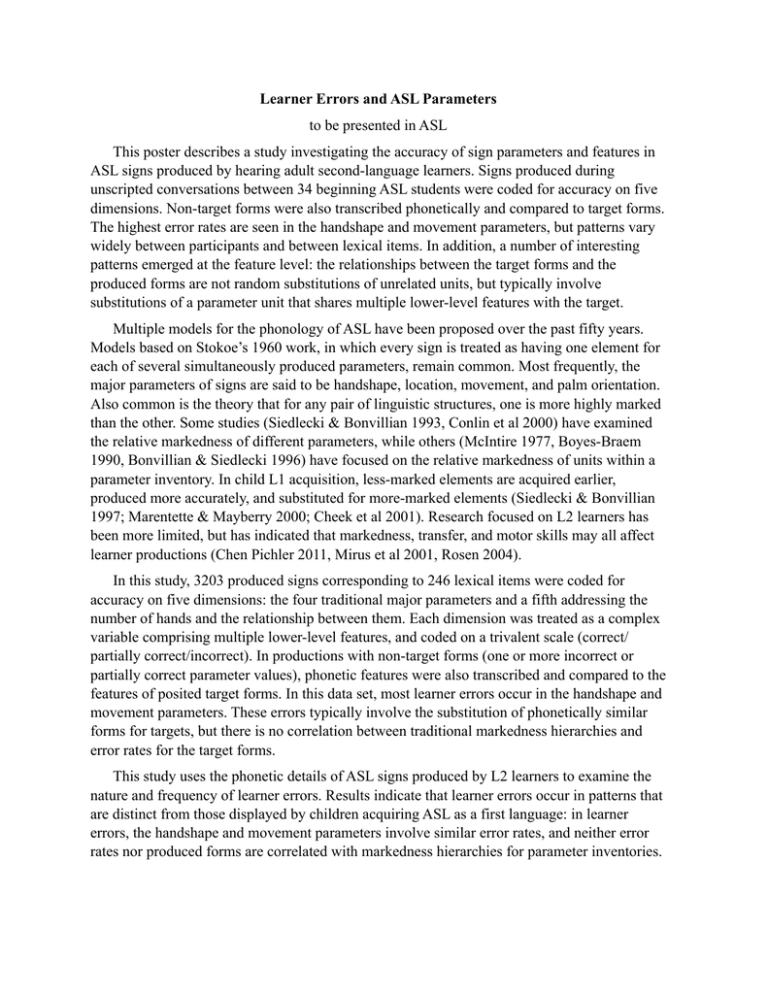
Learner Errors and ASL Parameters to be presented in ASL This poster describes a study investigating the accuracy of sign parameters and features in ASL signs produced by hearing adult second-language learners. Signs produced during unscripted conversations between 34 beginning ASL students were coded for accuracy on five dimensions. Non-target forms were also transcribed phonetically and compared to target forms. The highest error rates are seen in the handshape and movement parameters, but patterns vary widely between participants and between lexical items. In addition, a number of interesting patterns emerged at the feature level: the relationships between the target forms and the produced forms are not random substitutions of unrelated units, but typically involve substitutions of a parameter unit that shares multiple lower-level features with the target. Multiple models for the phonology of ASL have been proposed over the past fifty years. Models based on Stokoe’s 1960 work, in which every sign is treated as having one element for each of several simultaneously produced parameters, remain common. Most frequently, the major parameters of signs are said to be handshape, location, movement, and palm orientation. Also common is the theory that for any pair of linguistic structures, one is more highly marked than the other. Some studies (Siedlecki & Bonvillian 1993, Conlin et al 2000) have examined the relative markedness of different parameters, while others (McIntire 1977, Boyes-Braem 1990, Bonvillian & Siedlecki 1996) have focused on the relative markedness of units within a parameter inventory. In child L1 acquisition, less-marked elements are acquired earlier, produced more accurately, and substituted for more-marked elements (Siedlecki & Bonvillian 1997; Marentette & Mayberry 2000; Cheek et al 2001). Research focused on L2 learners has been more limited, but has indicated that markedness, transfer, and motor skills may all affect learner productions (Chen Pichler 2011, Mirus et al 2001, Rosen 2004). In this study, 3203 produced signs corresponding to 246 lexical items were coded for accuracy on five dimensions: the four traditional major parameters and a fifth addressing the number of hands and the relationship between them. Each dimension was treated as a complex variable comprising multiple lower-level features, and coded on a trivalent scale (correct/ partially correct/incorrect). In productions with non-target forms (one or more incorrect or partially correct parameter values), phonetic features were also transcribed and compared to the features of posited target forms. In this data set, most learner errors occur in the handshape and movement parameters. These errors typically involve the substitution of phonetically similar forms for targets, but there is no correlation between traditional markedness hierarchies and error rates for the target forms. This study uses the phonetic details of ASL signs produced by L2 learners to examine the nature and frequency of learner errors. Results indicate that learner errors occur in patterns that are distinct from those displayed by children acquiring ASL as a first language: in learner errors, the handshape and movement parameters involve similar error rates, and neither error rates nor produced forms are correlated with markedness hierarchies for parameter inventories. References Bonvillian, John D. and Theodore Siedlecki Jr.. 1996. Young children’s acquisition of the location aspect of American Sign Language signs: Parental report findings. Journal of Communication Disorders 29:1, 13–36. Boyes-Braem, Penny. 1990. Acquisition of the handshape in American Sign Language: A preliminary analysis. In Virginia Volterra and Carol Erting, editors, From gesture to language in hearing and deaf children, 107–127. Springer Verlag. Chen Pichler, Deborah. 2011. Sources of handshape error in first-time signers of ASL. In Gaurav Mathur and Donna Jo Napoli, editors, Deaf around the world: The impact of language, 96–121. Oxford University Press. Conlin, Kimberly E., Gene R. Mirus, Claude Mauk, & Richard P. Meier. 2000. The acquisition of first signs: Place, handshape and movement. In Jill P. Morford and Rachel I. Mayberry, editors, Language acquisition by eye, 51–69. Lawrence Erlbaum Associates. Marentette, Paula F. & Rachel I. Mayberry. 2000. Principles for an emerging phonological system: a case study of early ASL acquisition. In Jill P. Morford and Rachel I. Mayberry, editors, Language acquisition by eye, 71–90. Lawrence Erlbaum Associates. McIntire, Marina L.. 1977. The acquisition of American Sign Language hand configuration. Sign Language Studies 16, 247–266. Mirus, Gene R., Christian Rathmann, & Richard P. Meier. 2001. Proximalization and distalization of sign movement in adult learners. In Valerie L. Dively, Melanie Metzger, Sarah Taub, and Anne Marie Baer, editors, Signed Languages: Discoveries from International Research, 103–119. Gallaudet University Press. Rosen, Russel S.. 2004. Beginning L2 production errors in ASL lexical phonology: A cognitive phonology model. Sign Language & Linguistics 7:1, 31-61. Siedlecki Theodore & John D. Bonvillian. 1993. Location, handshape & movement: Young children's acquisition of the formational aspects of American Sign Language. Sign Language Studies 78, 31-52. Stokoe, William C.. 1960. Sign language structure: An outline of the visual communication systems of the American deaf (Studies in Linguistics, Occasional Papers 8). Buffalo, NY: University of Buffalo.


